IEEE Std 1471-2000
IEEE Recommended Practice for
Architectural Description of
Software-Intensive Systems
Sponsor
Software Engineering Standards Committee
of the
IEEE Computer Society
Approved 21 September 2000
IEEE-SA Standards Board
architectural descriptions
Abstract:
This recommended practice addresses the activities of the creation, analysis, and sus-
tainment of architectures of software-intensive systems, and the recording of such architectures in
. A conceptual framework for architectural description is estab-
terms of
lished. The content of an architectural description is defined. Annexes provide the rationale for key
concepts and terminology, the relationships to other standards, and examples of usage.
Keywords:
cerns, system stakeholder, view, viewpoint
architectural description, architecture, software-intensive system, stakeholder con-
The Institute of Electrical and Electronics Engineers, Inc.
3 Park Avenue, New York, NY 10016-5997, USA
Copyright © 2000 by the Institute of Electrical and Electronics Engineers, Inc.
All rights reserved. Published 9 October 2000. Printed in the United States of America.
Print:
PDF:
ISBN 0-7381-2518-0 SH94869
ISBN 0-7381-2519-9 SS94869
No part of this publication may be reproduced in any form, in an electronic retrieval system or otherwise, without the prior
written permission of the publisher.
�
IEEE Standards
documents are developed within the IEEE Societies and the Standards Coordinating Com-
mittees of the IEEE Standards Association (IEEE-SA) Standards Board. Members of the committees serve
voluntarily and without compensation. They are not necessarily members of the Institute. The standards
developed within IEEE represent a consensus of the broad expertise on the subject within the Institute as
well as those activities outside of IEEE that have expressed an interest in participating in the development of
the standard.
Use of an IEEE Standard is wholly voluntary. The existence of an IEEE Standard does not imply that there
are no other ways to produce, test, measure, purchase, market, or provide other goods and services related to
the scope of the IEEE Standard. Furthermore, the viewpoint expressed at the time a standard is approved and
issued is subject to change brought about through developments in the state of the art and comments
received from users of the standard. Every IEEE Standard is subjected to review at least every five years for
revision or reaffirmation. When a document is more than five years old and has not been reaffirmed, it is rea-
sonable to conclude that its contents, although still of some value, do not wholly reflect the present state of
the art. Users are cautioned to check to determine that they have the latest edition of any IEEE Standard.
Comments for revision of IEEE Standards are welcome from any interested party, regardless of membership
affiliation with IEEE. Suggestions for changes in documents should be in the form of a proposed change of
text, together with appropriate supporting comments.
Interpretations: Occasionally questions may arise regarding the meaning of portions of standards as they
relate to specific applications. When the need for interpretations is brought to the attention of IEEE, the
Institute will initiate action to prepare appropriate responses. Since IEEE Standards represent a consensus of
all concerned interests, it is important to ensure that any interpretation has also received the concurrence of a
balance of interests. For this reason, IEEE and the members of its societies and Standards Coordinating
Committees are not able to provide an instant response to interpretation requests except in those cases where
the matter has previously received formal consideration.
Comments on standards and requests for interpretations should be addressed to:
Secretary, IEEE-SA Standards Board
445 Hoes Lane
P.O. Box 1331
Piscataway, NJ 08855-1331
USA
Note: Attention is called to the possibility that implementation of this standard may
require use of subject matter covered by patent rights. By publication of this standard,
no position is taken with respect to the existence or validity of any patent rights in
connection therewith. The IEEE shall not be responsible for identifying patents for
which a license may be required by an IEEE standard or for conducting inquiries into
the legal validity or scope of those patents that are brought to its attention.
IEEE is the sole entity that may authorize the use of certification marks, trademarks, or other designations to
indicate compliance with the materials set forth herein.
Authorization to photocopy portions of any individual standard for internal or personal use is granted by the
Institute of Electrical and Electronics Engineers, Inc., provided that the appropriate fee is paid to Copyright
Clearance Center. To arrange for payment of licensing fee, please contact Copyright Clearance Center, Cus-
tomer Service, 222 Rosewood Drive, Danvers, MA 01923 USA; (978) 750-8400. Permission to photocopy
portions of any individual standard for educational classroom use can also be obtained through the Copy-
right Clearance Center.
�
Introduction
(This introduction is not part of IEEE Std 1471-2000,
Software-Intensive Systems
.)
IEEE Recommended Practice for Architectural Description of
It has long been recognized that “architecture” has a strong influence over the life cycle of a system. In the
past, hardware-related architectural aspects were dominant, whereas software-related architectural integrity,
when it existed, often was to be sacrificed first in the course of system development. Today, software-
intensive systems are pervasive. The cost of software development and the increasing complexity of software
systems have changed the relative balance. Software technology is maturing rapidly. The practice of system
development can benefit greatly from adherence to architectural precepts.
However, the concepts of architecture have not been consistently defined and applied within the life cycle of
software-intensive systems. Despite significant industrial and research activity in this area, there is no single,
accepted framework for codifying architectural thinking, thereby facilitating the common application and
evolution of available and emerging architectural practices.
The IEEE Architecture Planning Group (APG) was formed in August 1995 to address this need. The APG
was chartered by the IEEE Software Engineering Standards Committee (SESC) to set a direction for incor-
porating architectural thinking into IEEE standards. The result of the APG’s deliberations was to recommend
an IEEE activity with the following goals:
— To define useful terms, principles and guidelines for the consistent application of architectural pre-
cepts to systems throughout their life cycle
— To elaborate architectural precepts and their anticipated benefits for software products, systems, and
aggregated systems (i.e., “systems of systems”)
— To provide a framework for the colilection and consideration of architectural attributes and related
information for use in IEEE standards
— To provide a useful road map for the incorporation of architectural precepts in the generation, revi-
sion, and application of IEEE standards
In April 1996 SESC created the Architecture Working Group (AWG) to implement those recommendations.
Copyright © 2000 IEEE. All rights reserved.
iii
�
Participants
At the time this recommended practice was completed, the Architecture Working Group had the following
membership.
Basil Sherlund,
Chair
Ronald L. Wade,
Vice Chair
David Emery,
Rich Hilliard,
Vice Chair for Liaison
Secretary and Editor
Frank C. Belz
S. Jeromy Carriere
Mark Dehlin
Verlynda Dobbs
Nancy Eickelmann
Walter J. Ellis
William Gess
Vladan V. Jovanovic
Judith S. Kerner
Dwayne L. Knirk
Ron Kohl
Alexei E. Kotov
Philippe Kruchten
Simon Liu
Mark W. Maier
Bill McMullen
Fatima Mili
The following members of the balloting committee voted on this standard:
Edward A. Addy
Mario R. Barbacci
Edward E. Bartlett
Leo Beltracchi
Frank C. Belz
Richard E. Biehl
Edward R. Byrne
Lawrence Catchpole
Leslie Chambers
Keith Chow
Antonio M. Cicu
Sylvain Clermont
Rosemary Coleman
Darrell Cooksey
Paul R. Croll
Gregory T. Daich
Bostjan K. Derganc
Perry R. DeWeese
Verlynda Dobbs
Franz D. Engelmann
William Eventoff
Jonathan H. Fairclough
John W. Fendrich
John H. Fowler
Eva Freund
Andrew Gabb
Juan Garbajosa-Sopena
Hiranmay Ghosh
Marilyn Ginsberg-Finner
Julio Gonzalez-Sanz
Lewis Gray
L. M. Gunther
John Harauz
Herbert Hecht
Mark Henley
John W. Horch
George Jackelen
Frank V. Jorgensen
Vladan V. Jovanovic
William S. Junk
Judith S. Kerner
Thomas M. Kurihara
Helmut Kurzdorfer
Kyoung-In Kwon
J. Dennis Lawrence
Thomas B. Lindahl
Jim J. Logan
Henry A. Malec
Tomoo Matsubara
Ian R. McChesney
James W. Moore
Frederick I. Moxley
Francisco Navas Plano
Glenn Plonk
Peter T. Poon
Dave Rayford
Ann Reedy
Ira Sachs
Thomas F. Saunders
M. Wayne Shiveley
Louise Tamres
Pavol Navrat
Gerald L. Ourada
Alex Polack
R. Razouk
Annette D. Reilly
Helmut Sandmayr
Frederico Sousa Santos
Robert J. Schaaf
Carl A. Singer
Richard S. Sky
Mitchell W. Smith
Fred J. Strauss
Sandra Swearingen
Toru Takeshita
Richard H. Thayer
Booker Thomas
Leonard L. Tripp
Theodore J. Urbanowicz
Tom Vaiskunas
Ronald L. Wade
Randall K. Walters
Larry L. Wear
Charles J. Wertz
Scott A. Whitmire
Paul R. Work
Natalie C. Yopconka
Geraldine Zimmerman
iv
Copyright © 2000 IEEE. All rights reserved.
�
When the IEEE-SA Standards Board approved this standard on 21 September 2000, it had the following
membership:
Donald N. Heirman,
Chair
James T. Carlo,
Vice Chair
Judith Gorman,
Secretary
James H. Gurney
Richard J. Holleman
Lowell G. Johnson
Robert J. Kennelly
Joseph L. Koepfinger*
Peter H. Lips
L. Bruce McClung
Daleep C. Mohla
James W. Moore
Robert F. Munzner
Ronald C. Petersen
Gerald H. Peterson
John B. Posey
Gary S. Robinson
Akio Tojo
Donald W. Zipse
Satish K. Aggarwal
Mark D. Bowman
Gary R. Engmann
Harold E. Epstein
H. Landis Floyd
Jay Forster*
Howard M. Frazier
Ruben D. Garzon
*Member Emeritus
Also included is the following nonvoting IEEE-SA Standards Board liaison:
Alan Cookson,
Donald R. Volzka,
NIST Representative
TAB Representative
Noelle D. Humenick
IEEE Standards Project Editor
Copyright © 2000 IEEE. All rights reserved.
v
�
Contents
1.
Overview.............................................................................................................................................. 1
1.1 Scope............................................................................................................................................ 1
1.2 Purpose......................................................................................................................................... 1
1.3 Intended users .............................................................................................................................. 2
1.4 Conformance to this recommended practice................................................................................ 3
2.
3.
4.
References............................................................................................................................................ 3
Definitions............................................................................................................................................ 3
Conceptual framework......................................................................................................................... 4
4.1 Architectural description in context............................................................................................. 4
4.2 Stakeholders and their roles ......................................................................................................... 6
4.3 Architectural activities in the life cycle ....................................................................................... 6
4.4 Uses of architectural descriptions ................................................................................................ 8
5.
Architectural description practices ...................................................................................................... 8
5.1 Architectural documentation........................................................................................................ 8
5.2 Identification of stakeholders and concerns................................................................................. 9
5.3 Selection of architectural viewpoints........................................................................................... 9
5.4 Architectural views .................................................................................................................... 10
5.5 Consistency among architectural views..................................................................................... 11
5.6 Architectural rationale ............................................................................................................... 11
5.7 Example use ............................................................................................................................... 11
Annex A (informative) Bibliography............................................................................................................. 13
Annex B (informative) Notes on terminology ............................................................................................... 14
Annex C (informative) Examples of viewpoints ........................................................................................... 17
Annex D (informative) Relationship to other standards ................................................................................ 20
vi
Copyright © 2000 IEEE. All rights reserved.
�
IEEE Recommended Practice for
Architectural Description of
Software-Intensive Systems
1. Overview
1.1 Scope
This recommended practice addresses the architectural description of software-intensive systems. A
is any system where software contributes essential influences to the design,
software-intensive system
construction, deployment, and evolution of the system as a whole.
The scope of this recommended practice encompasses those products of system development that capture
architectural information. This includes architectural descriptions that are used for the following:
a)
b)
c)
d)
e)
f)
g)
Expression of the system and its evolution
Communication among the system stakeholders
Evaluation and comparison of architectures in a consistent manner
Planning, managing, and executing the activities of system development
Expression of the persistent characteristics and supporting principles of a system to guide acceptable
change
Verification of a system implementation’s compliance with an architectural description
Recording contributions to the body of knowledge of software-intensive systems architecture
1.2 Purpose
The purpose of this recommended practice is to facilitate the expression and communication of architectures
and thereby lay a foundation for quality and cost gains through standardization of elements and practices for
architectural description.
Despite significant efforts to improve engineering practices and technologies, software-intensive systems
continue to present formidable risks and difficulties in their design, construction, deployment, and evolution.
Recent attempts to address these difficulties have focused on the earliest period of design decision-making
and evaluation, increasingly referred to as the
archi-
of system development. The phrases
architectural level
Copyright © 2000 IEEE. All rights reserved.
1
�
IEEE
Std 1471-2000
IEEE RECOMMENDED PRACTICE FOR
and
level
architecture
are widely, if imprecisely, used. Their use reflects acceptance of an architec-
tectural
tural metaphor in the analysis and development of software-intensive systems. A key premise of this
metaphor is that important decisions may be made early in system development in a manner similar to the
early decision-making found in the development of civil architecture projects.
Many innovations are resulting from this attention to the architectural level, among them architectural
description languages and associated tools and environments; architectural frameworks, models, and
patterns; and techniques for architectural analysis, evaluation, and architecture-based reuse. While these
efforts differ considerably in important aspects, sufficient commonality exists to warrant the development of
a recommended practice to codify their common elements.
architectural level of systems development
These innovations are occurring, and maturing, rapidly within many research and application communities,
and they reflect differing interests, influences, insights, and intentions. There is a general consensus on the
, and that that level consists of early decision-
importance of the
making about overall design structure, goals, requirements, and development strategies. However, there has
not yet emerged any reliable consensus on a precise definition of a system’s
, i.e., how it should
be described, what uses such a description may serve, or where and when it should be defined. The bound-
aries and relationships between architectural trends and practices, and other practices; and between architec-
tural technology and other technology, are not yet widely recognized.
architecture
In such situations, progress often depends on mediating influences. Potential adopters of architectural
practices and technology need a frame of reference within which to address implementation and adoption
decisions. Technology developers need a frame of reference within which to communicate the motivating
concepts of their technology, and to accumulate and appreciate feedback from early adoption.
To these ends, this recommended practice is intended to reflect generally accepted trends in practices for
architectural description and to provide a technical framework for further evolution in this area.
Furthermore, it establishes a conceptual framework of concepts and terms of reference within which future
developments in system architectural technology can be deployed. This recommended practice codifies
those elements on which there is consensus; specifically the use of multiple views, reusable specifications
for models within views, and the relation of architecture to system context.
1.3 Intended users
The principal class of users for this recommended practice comprises stakeholders in system development
and evolution, including the following:
— Those that use, own, and acquire the system (users, operators, and acquirers, or
— Those that develop, describe, and document architectures (architects)
— Those that develop, deliver, and maintain the system (architects, designers, programmers, maintain-
ers, testers, domain engineers, quality assurance staff, configuration management staff, suppliers,
and project managers or
)
developers
)
clients
— Those who oversee and evaluate systems and their development (chief information officers, auditors,
and independent assessors)
A secondary class of users of this recommended practice comprises those involved in the enterprise-wide
infrastructure activities that span multiple system developments, including methodologists, process and pro-
cess-improvement engineers, researchers, producers of standards, tool builders, and trainers.
2
Copyright © 2000 IEEE. All rights reserved.
�

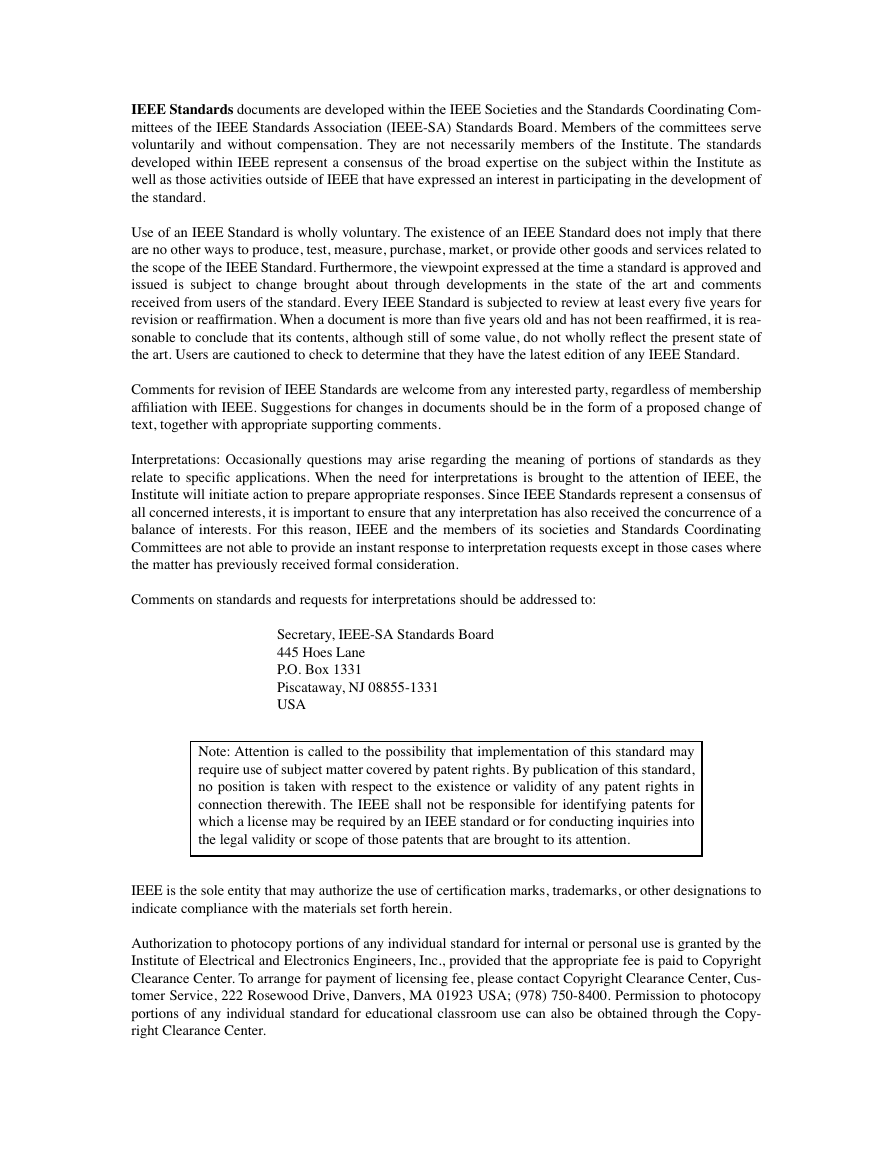

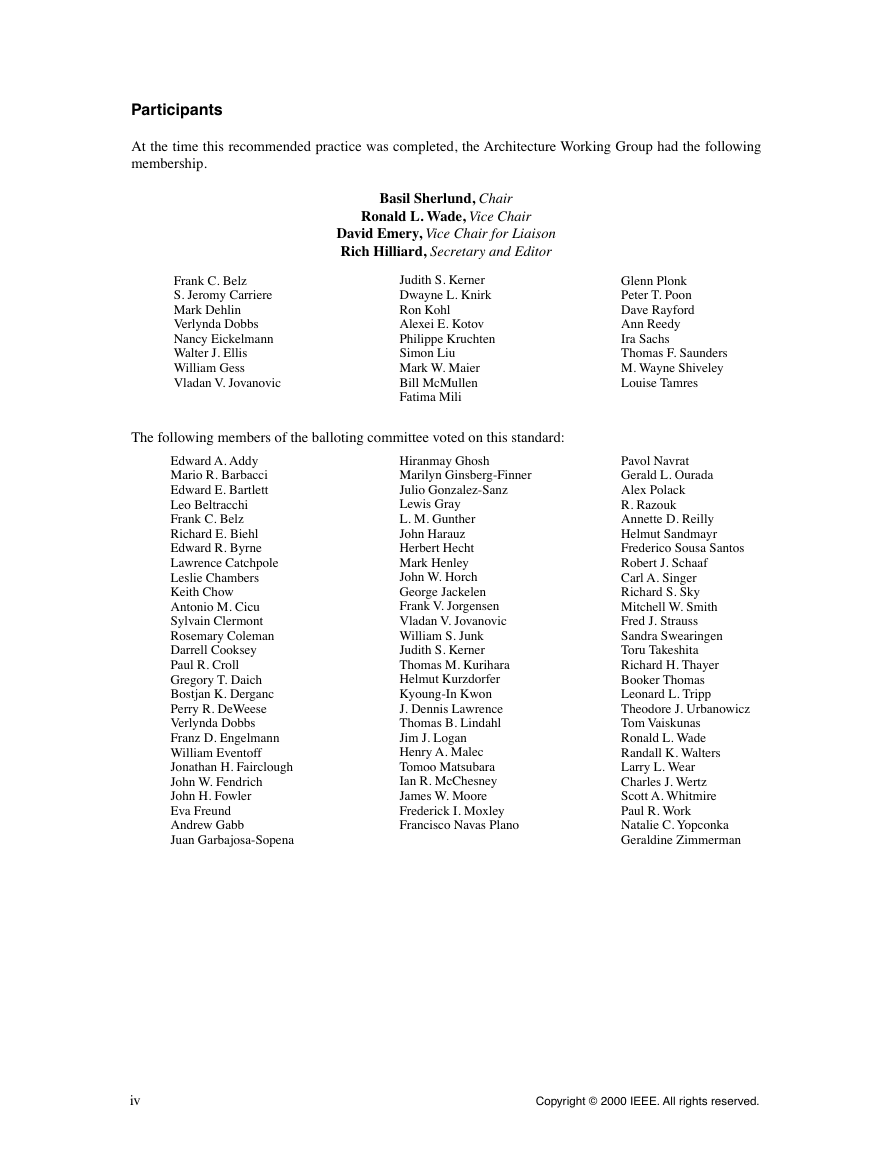
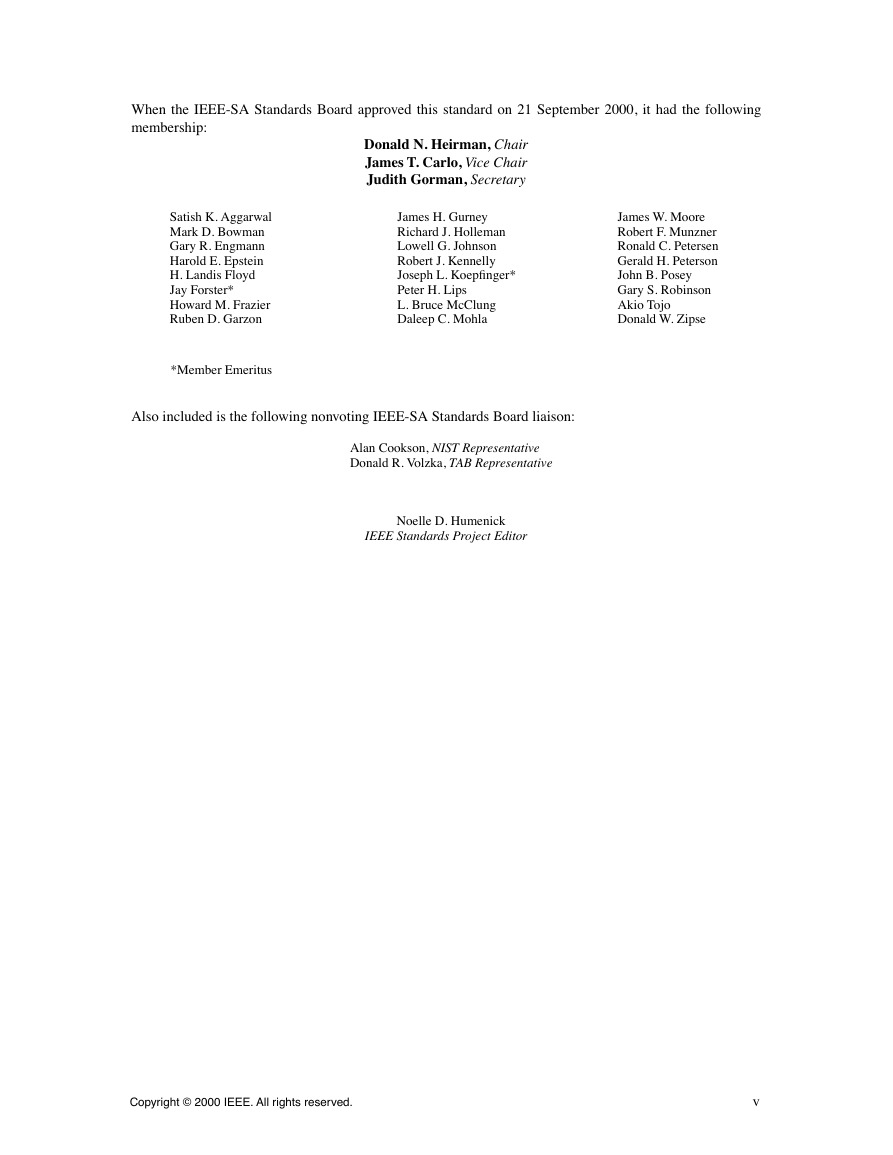

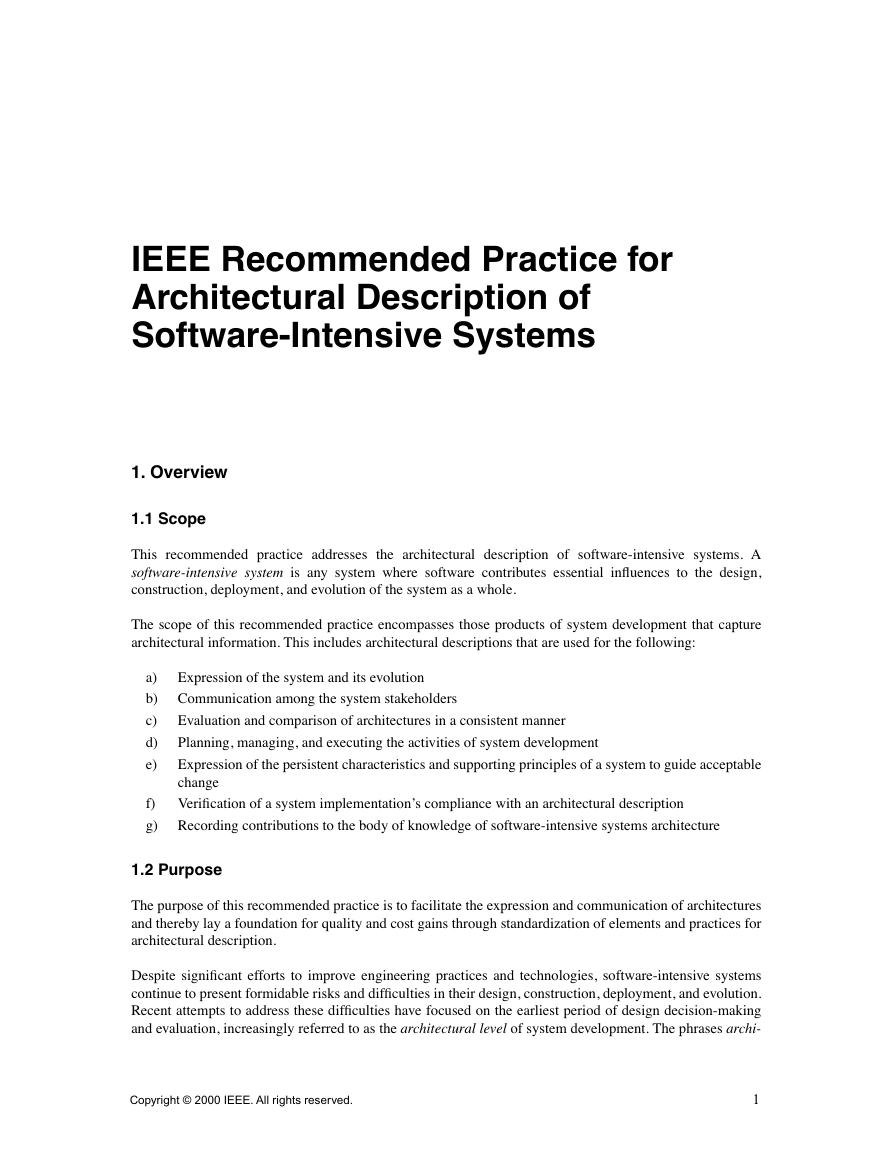
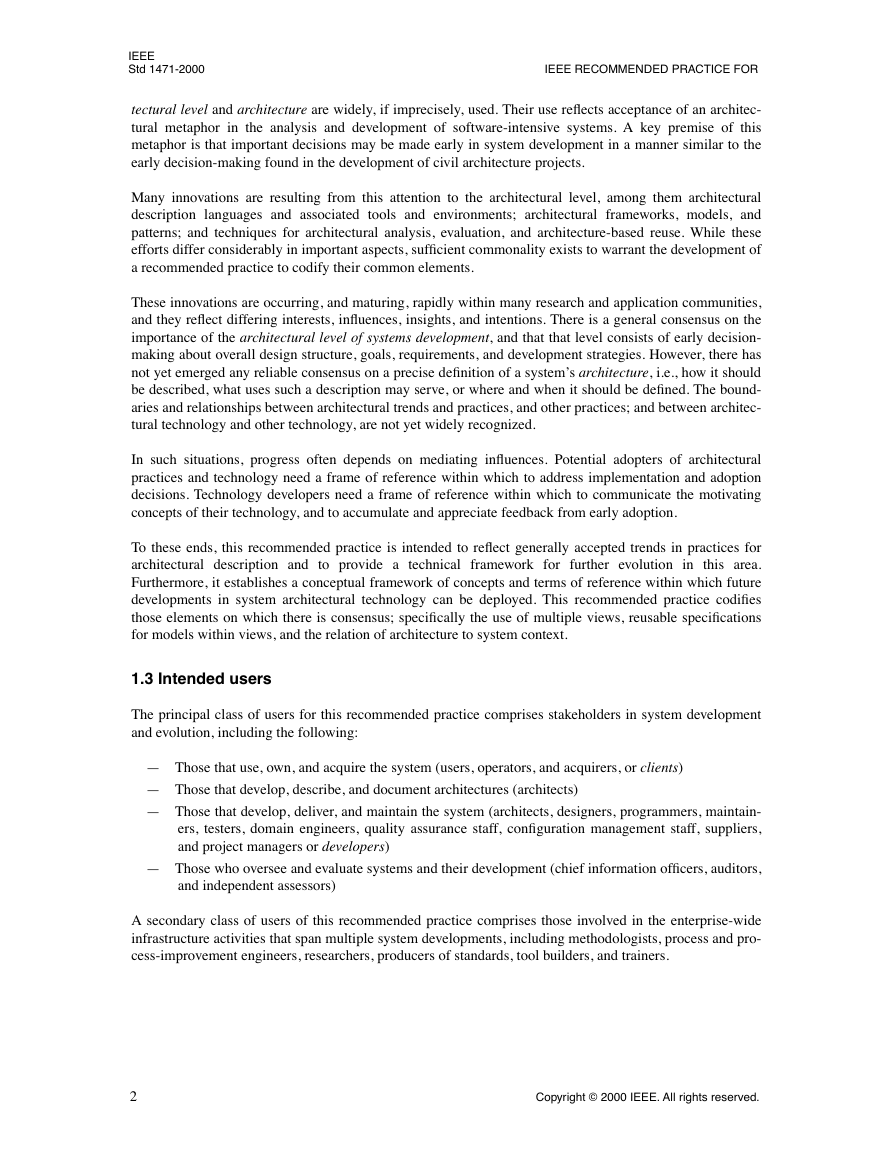








 2023年江西萍乡中考道德与法治真题及答案.doc
2023年江西萍乡中考道德与法治真题及答案.doc 2012年重庆南川中考生物真题及答案.doc
2012年重庆南川中考生物真题及答案.doc 2013年江西师范大学地理学综合及文艺理论基础考研真题.doc
2013年江西师范大学地理学综合及文艺理论基础考研真题.doc 2020年四川甘孜小升初语文真题及答案I卷.doc
2020年四川甘孜小升初语文真题及答案I卷.doc 2020年注册岩土工程师专业基础考试真题及答案.doc
2020年注册岩土工程师专业基础考试真题及答案.doc 2023-2024学年福建省厦门市九年级上学期数学月考试题及答案.doc
2023-2024学年福建省厦门市九年级上学期数学月考试题及答案.doc 2021-2022学年辽宁省沈阳市大东区九年级上学期语文期末试题及答案.doc
2021-2022学年辽宁省沈阳市大东区九年级上学期语文期末试题及答案.doc 2022-2023学年北京东城区初三第一学期物理期末试卷及答案.doc
2022-2023学年北京东城区初三第一学期物理期末试卷及答案.doc 2018上半年江西教师资格初中地理学科知识与教学能力真题及答案.doc
2018上半年江西教师资格初中地理学科知识与教学能力真题及答案.doc 2012年河北国家公务员申论考试真题及答案-省级.doc
2012年河北国家公务员申论考试真题及答案-省级.doc 2020-2021学年江苏省扬州市江都区邵樊片九年级上学期数学第一次质量检测试题及答案.doc
2020-2021学年江苏省扬州市江都区邵樊片九年级上学期数学第一次质量检测试题及答案.doc 2022下半年黑龙江教师资格证中学综合素质真题及答案.doc
2022下半年黑龙江教师资格证中学综合素质真题及答案.doc